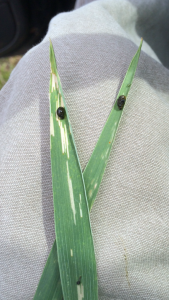Cereal Leaf Beetles
The cereal leaf beetle has one generation per year. Adult beetles spend the winter in the woods and field borders. During the first warm days of spring, the beetles disperse into small grain fields, mate, and begin to lay eggs. Eggs hatch in about 7 days, and larvae (immatures) begin to feed on the cereal leaves. Larvae are usually first found after flag leaf emergence but before the heads have emerged. The larvae feed for about 3 to 4 weeks, then leave the plant, and move down into the soil. Cereal leaf beetles transform from the larval to the adult stage in earthen cells in the upper 2 inches of soil. This transformation (pupal) stage lasts about 10 days. The adults of the new generation come out in late May and early June, feed briefly, then move out of the fields, and remain inactive until the following spring. New generation adults may feed on corn leaves but seldom cause serious damage. Cereal leaf beetle larvae are pale yellow with a brown head and legs (Figure 1). In the field, they look mostly black because they smear excrement over their bodies. In (Figure 1), I scratched off the slime to reveal the yellow body. People walking through a field infested with cereal leaf beetle larvae may emerge with black stained pant legs because this black coating easily rubs off the larvae.
Although both adults and larvae feed on plant tissues, the larvae are the primary damaging stage. They feed on the leaf surface, removing all the green material down to the lower cuticle leaving an elongated feeding scar described as a ‘windowpane’ parallel to the leaf veins (Figures 1 and 2). Severe feeding damage can look like frost damage.
Crop damage by CLB may result in significant yield and quality reduction such as lowered grade and reduced economic returns to producers. In Georgia, this is usually not an economic pest, but this year we seem to be finding them everywhere.
(CLB life stage information from Alabama Cooperative Extension Service)

